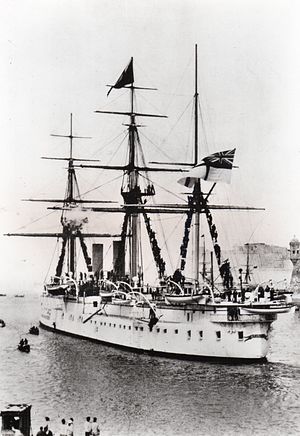HMS Alexandra

HMS Alexandra in 1886
|
|
| History | |
|---|---|
|
|
|
| Namesake: | Alexandra, Princess of Wales |
| Builder: | Chatham Dockyard |
| Laid down: | 5 March 1873 |
| Launched: | 7 April 1875 |
| Commissioned: | 31 January 1877 |
| Fate: | Sold 1908 and broken up |
| General characteristics | |
| Displacement: | 9,490 tons |
| Length: | 325 ft (99 m) pp, 344 ft (105 m) oa |
| Beam: | 63 ft 8 in (19.41 m) |
| Draught: | 26 ft 6 in (8.08 m) |
| Propulsion: | 2-shaft Humphreys vertical inverted compound, 8,498 ihp (6.337 MW) |
| Speed: | 15.09 knots (27.95 km/h; 17.37 mph) |
| Complement: | 674 |
| Armament: |
|
| Armour: |
|
HMS Alexandra was a central battery ironclad of the Victorian Royal Navy, whose seagoing career was from 1877 to 1900. She spent much of her career as a flagship, and took part in operations to deter Russian aggression against Turkey in 1878 and the bombardment of Alexandria in 1882.
At the time of her design the Board of Admiralty were at loggerheads amongst themselves as regards the provision of sails in their contemporary warships; steam engine design had advanced to the point where ships could cross the Atlantic under steam power alone, but centuries of tradition had left an ingrained emotional attachment to sails in a small but influential number of the senior members of the naval hierarchy. This minority succeeded in convincing the Board to design Alexandra as a rigged broadside vessel.
Built at Chatham Dockyard and engined by Messers Humphreys and Tennant, Alexandra was the last of a long series of progressive steps in the development of vessels of her type. As the militarily most effective of all of the broadside ironclads, it is ironic that she was designed by Nathaniel Barnaby, who was one of the earliest and most effective proponents of the virtues of turret-mounted artillery.
Her armament was disposed in a central box battery, with heavy guns deployed both on the main and on the upper deck. Recognising the increasing importance of axial fire, Barnaby arranged the artillery so that, by firing through embrasures, there was the capability of deploying four heavy guns to fire dead ahead, and two astern; all guns could if required fire on the broadside.
Alexandra was the last British battleship to carry her main armament wholly below decks; she was one of only two British ships to mount guns of 11-inch (280 mm) calibre, the other being HMS Temeraire.
She was the first British warship to be powered by vertical compound engines, carrying cylindrical high-pressure boilers with a working pressure of 60 pounds-force per square inch (410 kPa), as compared to rectangular boilers working at 30 lbf/in2 (210 kPa) pressure mounted in earlier ships. Twelve boilers were set back to back on either side of a longitudinal bulkhead; each engine drove an outward rotating screw of some 21 feet (6 m) in diameter. A pair of auxiliary engines, each of 600 indicated horsepower (450 kW), were fitted to turn the screws while the ship was proceeding under sail. These engines could, if required, propel the ship at a speed of 14.5 knots (26.9 km/h). At the time of her completion Alexandra was the fastest battleship afloat.
...
Wikipedia
